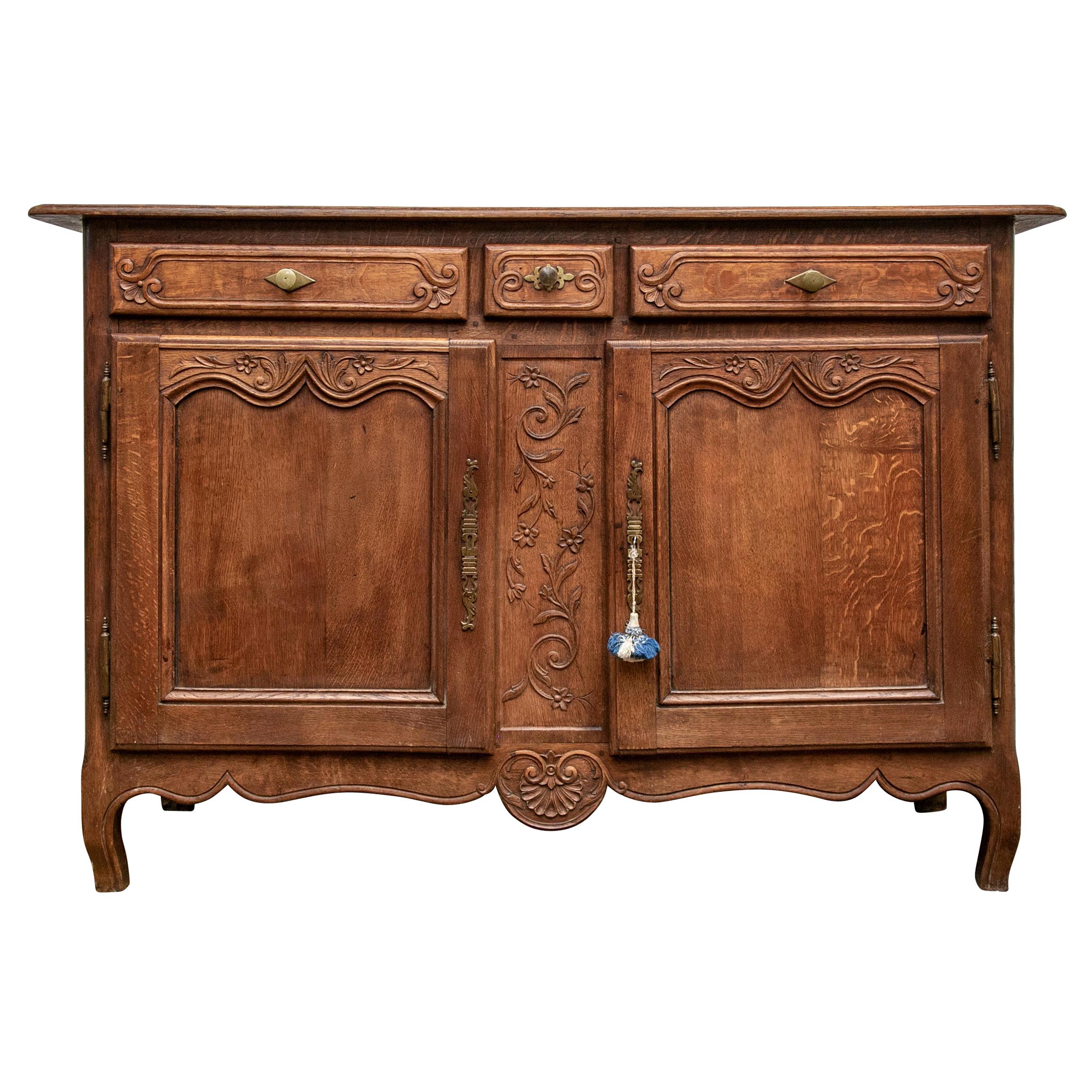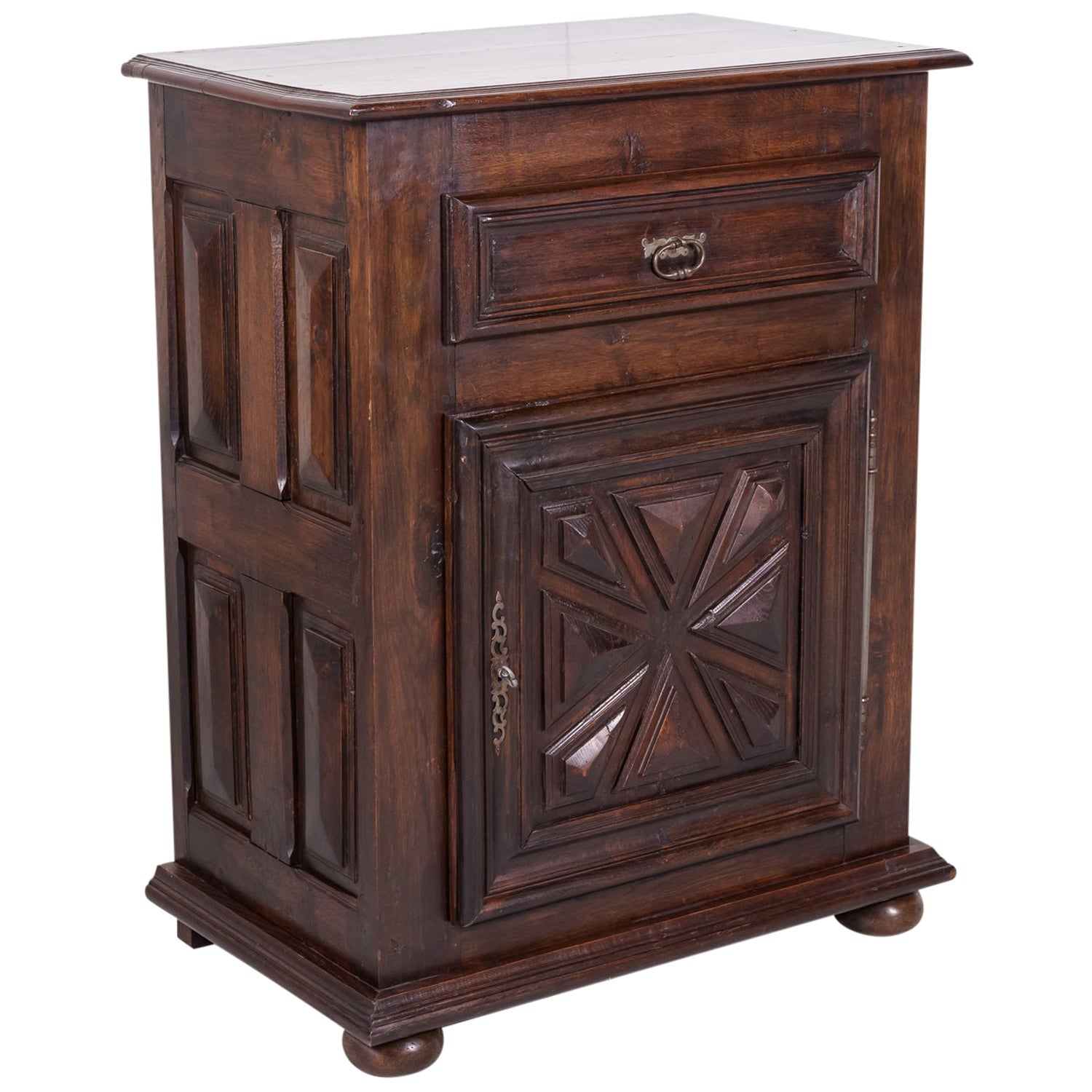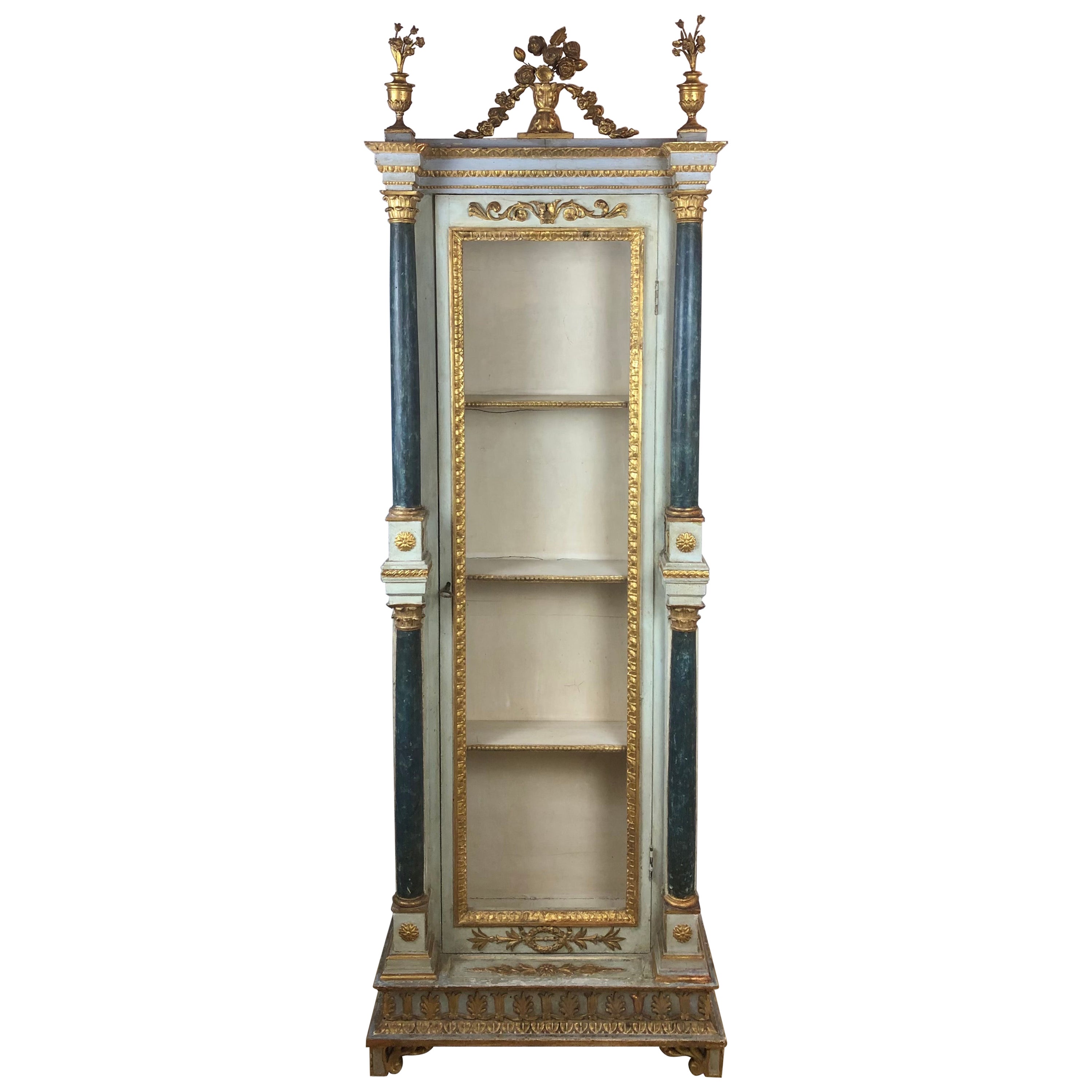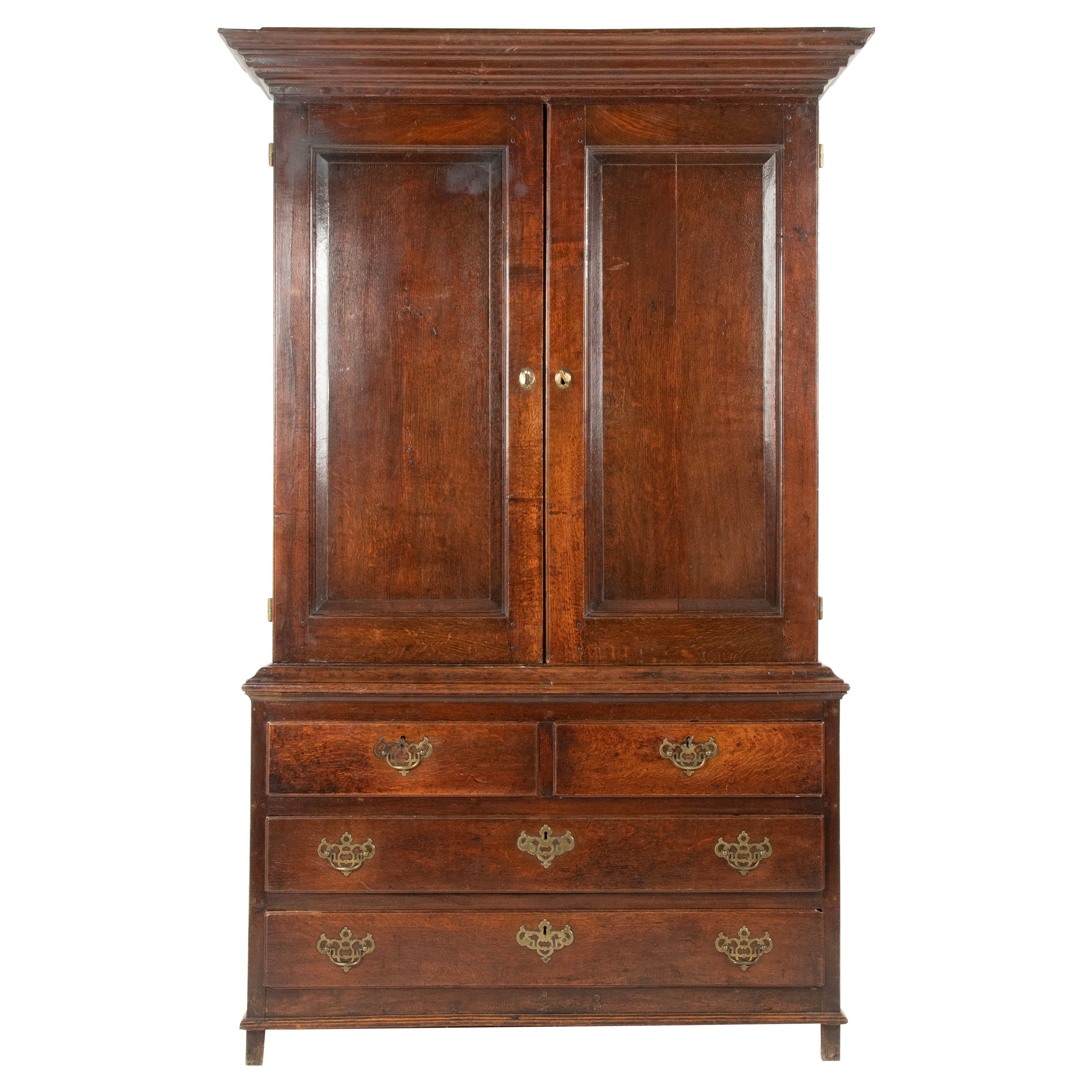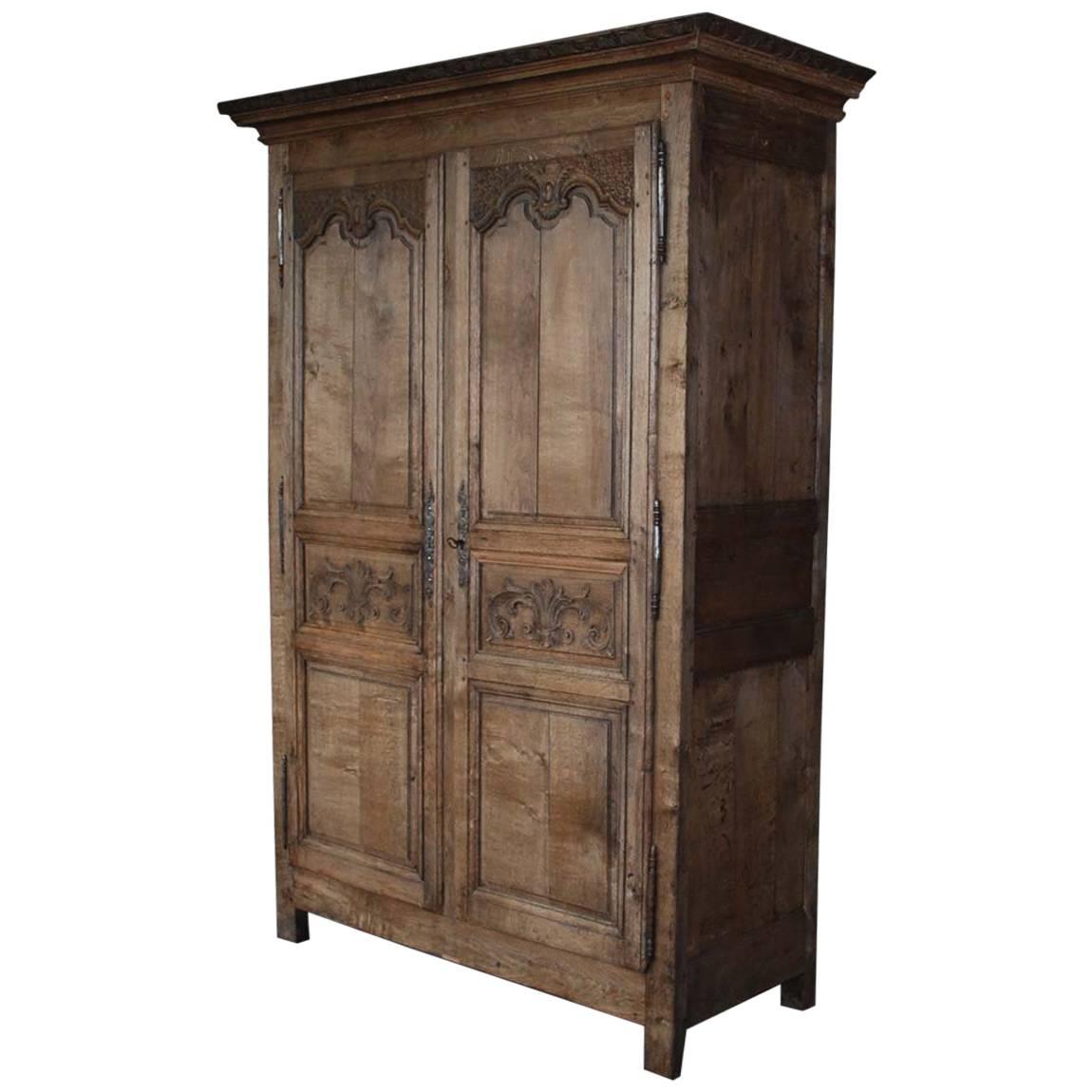Items Similar to Oak Wedding Cabinet, Normandy, Period, Late 18th-Early 19th Century
Want more images or videos?
Request additional images or videos from the seller
1 of 7
Oak Wedding Cabinet, Normandy, Period, Late 18th-Early 19th Century
About the Item
Important Norman wedding cabinet, old oak of very good quality.
It consists of a straight body with straight uprights topped by a horizontal cornice. This crowning, very worked and richly decorated with a splendid medallion of sculptures in relief representing a basket of abundance, filled with roses and grapes surrounded by the two doves of Love.
On each one is represented, the second part of the eighteenth fable of the book I of Jean de La Fontaine located in the first collection of the Fables of La Fontaine, published for the first time in 1668, "The Fox and the Stork", it tells us, the revenge of the Stork, which in its turn invites the Fox to her house. The Stork prepares a delicious meat, but cut in small pieces and put in a vase with a long neck, depriving the Fox of his meal.
It opens on three beautiful shelves and a drawer in perfect condition.
The lock and the key are also original.
Period : End of 18th century - Beginning of 19th century
Dimensions : Height : 230cm x Width : 148cm x Depth : 48cm
It is in the 18th century that the Norman wardrobe takes its characteristic shape, it combines structure and Louis XV repertoire with Louis XVI motifs.
It is at this same time of economic and social stability allowing a certain elevation of the living conditions that it enters the bourgeois and peasant residences.
Today, it still symbolizes in the eyes of all marriage and creation of the new home.
It was brought as a dowry by the bride along with her trousseau.
The sculptures were varied. The profession or the hobby of the father of the bride could inspire them. What message did the father of our future bride want to convey on this magnificent piece?
The Norman wardrobe has both an emotional charge but it also symbolizes family wealth.
- Dimensions:Height: 90.56 in (230 cm)Width: 58.27 in (148 cm)Depth: 18.9 in (48 cm)
- Materials and Techniques:
- Period:
- Date of Manufacture:19th Century
- Condition:
- Seller Location:CRÉTEIL, FR
- Reference Number:1stDibs: LU7814232846112
About the Seller
4.0
Vetted Seller
These experienced sellers undergo a comprehensive evaluation by our team of in-house experts.
1stDibs seller since 2022
9 sales on 1stDibs
Typical response time: Several days
- ShippingRetrieving quote...Ships From: CRÉTEIL, France
- Return PolicyA return for this item may be initiated within 14 days of delivery.
More From This SellerView All
- Natural Stone Sculpture - Sodalite - China - Late 19th Century PeriodLocated in CRÉTEIL, FRA very fine piece of natural stone, Sodalite, made in China. Finely chiselled, this large statue depicts a scene of life in which several ancient symbols stand side by side, such as the Phoenix, swallows, a horse, earthly abundance with its luxuriant vegetation, fruit, but also food from the ocean and its generous fish, a man, a woman and a child. First discovered in Greenland in 1806, Sodalite was analysed by a Scottish chemist 5 years later (1811), Mr Thomas Thomson. Several long years went by without it achieving any real success. It was not until 1891 that the stone was recognised as an ornamental stone. It was during a diplomatic trip to Canada in 1901 that Mary de Teck (wife of King George V) discovered Sodalite and fell under the spell of this natural stone. The princess ordered a large quantity of Sodalite to decorate her London flats. Sodalite quickly became fashionable. Period: Late 19th century - Napoleon III Dimensions: Total height with base: 92cm x Width: 31.5cm x Depth: 27cm Dimensions of wooden base: Height: 7cm x Length: 25cm x Width: 23cm But what do these symbols mean? The phoenix, a mythological bird, symbolises purification and rebirth, as it is said to rise from its own ashes. This magnificent bird is also synonymous with good fortune, opportunity and luck in Asian cultures. In feng shui, the phoenix is also one of the four celestial animals (sometimes also known as the red bird or red raven). The red phoenix...Category
Antique 19th Century Chinese Other Abstract Sculptures
MaterialsStone
- Pair of Quinquet, White Opaline, Maison Baccarat, Period: Early 19th CenturyLocated in CRÉTEIL, FRSuperb pair of "quinquets" or oil lamps from Baccarat. The foot which acts as a reservoir is cylindrical in white opaline called "ball". The gilt bronze collar supports an original...Category
Antique 19th Century French Restauration Candle Lamps
MaterialsOpal
- Old Lard Stone, Vine and Grapes, Period, Late 19th Century, Quing DynastyLocated in CRÉTEIL, FRVery beautiful Far Eastern work in "lard stone". The finely carved base is in brown stone. This sculpture represents a vine with generous and abundant foliage and bunches of grape...Category
Antique 19th Century Asian Napoleon III Vases
MaterialsStone, Marble
- Cylinder Desk, Victorian Period, Flamed Mahogany, 19th CenturyLocated in CRÉTEIL, FRMagnificent English made cylinder desk in flamed mahogany, Victorian period. Period : 19th century Dimensions : Height : 121cm x length : 138cm x depth : 79cm It has a small support on the top to hold candles or files in progress and a large barrel-fronted desk compartment with a quality interior. Once the cylinder is opened, it reveals the interior of the desk with 10 maple veneer drawers and 6 pigeon holes to hold letters or any type of document to be sent or awaiting processing. This desk has a slide at the front which has three compartments covered with original leather allowing on each side to leave the writings in progress for the left part, the inkwell and the writing utensils for the right part and a slope of writing which can be raised for the central part. This first part rests on two pedestal bases, each composed of a series of three lockable drawers, equipped with original mahogany handles. Both bases are still equipped with their original brass castors, making the desk easy to manoeuvre. The desk is therefore divided into three individual sections, making it easy to transport and reassemble. The originality of this piece of furniture lies in its closing mechanism. A cylinder is a movable flap that folds down or up over a series of compartments and drawers, closing the top box of the desk to protect personal documents. In the early models, the cylinder consisted of a relatively fragile system of slatted curtains. This was soon replaced by a rigid quarter-circle panel...Category
Antique 19th Century English Desks and Writing Tables
MaterialsMahogany
- Illuminated Late 18th Century, Golden Frame with Gold LeafLocated in CRÉTEIL, FRSublime illumination from the end of the 18th century. It is a sonnet which was composed, drawn and written by an elderly person, since his dedication mentions his seventy-fifth year, precisely dated by the author's care in 1771. Dimensions: H: 54 x W: 42cm The frame which is original has been fully restored, then fully gilded with gold leaf, presenting a double patina. We would like to thank the HB workshop and Henda Bayoudh for the care taken in this exceptional work which has spanned more than two centuries. The sonnet is certainly the most widely used fixed form of poetry. The recipes for the sonnet vary from time to time and each poet tries to add his own personal touch. Made up of fourteen lines, originally from the Decasyllables, then especially from the Alexandrines, his lines are divided into three distinct stanzas, two quatrains followed by a sizain, separated into two tercets. Here our eyes are amazed at the agility of this elderly man, who, guided by Love, gratitude and benevolence, was able to express his gratitude, through the different arts he mastered, writing and drawing. It is a thanksgiving, not intended directly for God but for one of his disciples, who on this earth was for him like the “Savior”. We will notice the quality and the care brought to the work, the symbolism is also very present and reveals the devotion of the artist. In the lower part of the work, the presence of the dog, the dog is the animal of Ahura Mazda...Category
Antique 18th Century Drawings
MaterialsGold Leaf
- Georgian Solid Mahogany Desk Says Knee, Late 18th CenturyLocated in CRÉTEIL, FRA small Georgian period mahogany knee-hole desk with blue leather sliding writing surface. It has a single full width central drawer topped by a hinged cupboard door in the knee ho...Category
Antique 18th Century Desks and Writing Tables
MaterialsMahogany
You May Also Like
- Late 18th-Early 19th Century French Carved Oak BuffettLocated in Bridgeport, CTAn antique Louis XV Provincial style server cabinet, the rectangular case fitted with one short drawer centered by two long drawers over double cabinet doors having recessed panels, ...Category
Antique Late 18th Century French French Provincial Cabinets
MaterialsOak
- Early 19th Century Louis XIII Oak Jam Cabinet or Confiturier from NormandyLocated in Birmingham, ALA tall early 19th century French Louis XIII style jam cabinet or confiturier from Normandy, circa 1820s. Handcrafted of old growth oak with a rectangular beveled edge top over a sing...Category
Antique 1820s French Louis XIII Cabinets
MaterialsOak
- Early 19th Century Oak Bookcase CabinetLocated in Martlesham, GB19th century oak bookcase cabinet of nice proportions, the arched cornice above three shelves with reeded edges supported by finely turned an...Category
Antique 1830s British William IV Cabinets
MaterialsOak
- Late 18th-Early 19th Century Carved Painted and Gilt Wood Venetian CabinetLocated in Miami, FLAn exquisite Venetian cabinet with remarkable Rococo period details. Gilt wood and painted in a very appealing and eye catching colors. This ornate Italian cabinet is decorated...Category
Antique Late 18th Century Italian Rococo Vitrines
MaterialsGiltwood, Wood
- Late 18th Century Georgian Oak Cabinet / CupboardLocated in Casteren, Noord-BrabantLate 18th century oak cupboard, The top part has two doors with fielded panels. The lower part has four drawers with brass handles. The cabin...Category
Antique 1780s British Georgian Cabinets
MaterialsBrass
- Early 19th Century French Wedding Cabinet or ArmoireLocated in Casteren, NLAn early 19th century oak wedding cabinet or Armoire from northern France. recessed panel sides, beautifull carved ornaments on the doors and moulding at the top. Original hardware...Category
Antique Early 19th Century French Cabinets
MaterialsOak
Recently Viewed
View AllMore Ways To Browse
19th Century Us Furniture
Old Oak
18th Century Long Case
Small Antique Oak Cabinet
Old Kitchen Storage
Small Locked Cabinet
Kitchen Book
La Period Furniture
Old Oak Cabinet
Two Doves
Depth Charge
New Used Kitchen Cabinets
Antique Neck Pieces
Late Eighteenth Century
Early Eighteenth Century
Cabinet Medallions
Oak Relief
Old Antique Kitchen Cabinets
